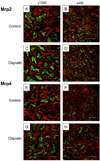Renal xenobiotic transporters are differentially expressed in mice following cisplatin treatment
- PMID: 18640236
- PMCID: PMC2570650
- DOI: 10.1016/j.tox.2008.06.009
Renal xenobiotic transporters are differentially expressed in mice following cisplatin treatment
Abstract
The goal of this study was to identify alterations in mRNA and protein expression of various xenobiotic transport proteins in mouse kidney during cisplatin-induced acute renal failure. For this purpose, male C57BL/6J mice received a single dose of cisplatin (18 mg/kg, i.p.) or vehicle. Four days later, tissues were collected for assessment of plasma BUN, histopathological analysis of renal lesions, and mRNA and Western blot analysis of renal transporters including organic anion and cation transporters (Oat, Oct), organic anion transporting polypeptides (Oatp), multidrug resistance-associated proteins (Mrp), multidrug resistance proteins (Mdr), breast cancer resistance protein (Bcrp) and multidrug and toxin extrusion proteins (Mate). Cisplatin treatment caused necrosis of renal proximal tubules along with elevated plasma BUN and renal kidney injury molecule-1 mRNA expression. Cisplatin-induced renal injury increased mRNA and protein levels of the efflux transporters Mrp2, Mrp4, Mrp5, Mdr1a and Mdr1b. Uptake transporters Oatp2a1 and Oatp2b1 mRNA were also up-regulated following cisplatin. By contrast, expression of Oat1, Oat2, Oct2 and Oatp1a1 mRNA was reduced in cisplatin-treated mice. Expression of several uptake and efflux transporters was unchanged in cisplatin-treated mice. Apical staining of Mrp2 and Mrp4 proteins was enhanced in proximal tubules from cisplatin-treated mice. Collectively, these expression patterns suggest coordinated regulation of uptake and efflux pathways during cisplatin-induced renal injury. Reduced expression of basolateral and apical uptake transporters along with enhanced transcription of export transporters likely represents an adaptation to lower intracellular accumulation of chemicals, prevent their reabsorption and enhance urinary clearance.
Conflict of interest statement
There are no conflicts of interest to report for the authors.
Figures





References
-
- Aleksunes LM, Slitt AM, Cherrington NJ, Thibodeau MS, Klaassen CD, Manautou JE. Differential expression of mouse hepatic transporter genes in response to acetaminophen and carbon tetrachloride. Toxicol Sci. 2005;83:44–52. - PubMed
-
- Alnouti Y, Petrick JS, Klaassen CD. Tissue distribution and ontogeny of organic cation transporters in mice. Drug Metab Dispos. 2006;34:477–482. - PubMed
-
- Bao Y, Pucci ML, Chan BS, Lu R, Ito S, Schuster VL. Prostaglandin transporter PGT is expressed in cell types that synthesize and release prostanoids. Am J Physiol Renal Physiol. 2002;282:F1103–F1110. - PubMed
-
- Buist SC, Klaassen CD. Rat and mouse differences in gender-predominant expression of organic anion transporter (Oat1-3; Slc22a6-8) mRNA levels. Drug Metab Dispos. 2004;32:620–625. - PubMed
-
- Chen ZS, Lee K, Kruh GD. Transport of cyclic nucleotides and estradiol 17-beta-D-glucuronide by multidrug resistance protein 4. Resistance to 6-mercaptopurine and 6-thioguanine. J Biol Chem. 2001;276:33747–33754. - PubMed
Publication types
MeSH terms
Substances
Grants and funding
LinkOut - more resources
Full Text Sources
Other Literature Sources

